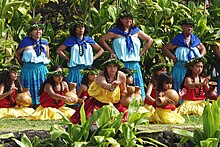
Back هاوائيون أصليون Arabic هاوائيين اصليين ARZ Гавайцы Byelorussian Natiu hawaià Catalan Hawaiier German Havajanoj Esperanto Hawaianos nativos Spanish بومیان هاوایی Persian Havaijilaiset Finnish Hawaïens French
This article needs additional citations for verification. (February 2024) |
Kānaka Maoli, Hawaiʻi Maoli | |
|---|---|
 | |
 Native Hawaiians performing a Hula | |
| Total population | |
| 527,077 (2010 census)[1] 156,456 (Native Hawaiian alone)[2] | |
| Regions with significant populations | |
| United States | 527,077 |
| Canada | 3,300[3] |
| New Zealand | 429[4] |
| Languages | |
| Religion | |
| Related ethnic groups | |
| Polynesians, other Pacific Islanders | |
Native Hawaiians (also known as Indigenous Hawaiians, Kānaka Maoli, Aboriginal Hawaiians, or simply Hawaiians; Hawaiian: kānaka, kānaka ʻōiwi, Kānaka Maoli, and Hawaiʻi maoli) are the Indigenous Polynesian people of the Hawaiian Islands.
Hawaii was settled at least 800 years ago by Polynesians who sailed from the Society Islands. The settlers gradually became detached from their homeland and developed a distinct Hawaiian culture and identity in their new home. They created new religious and cultural structures, in response to their new circumstances and to pass knowledge from one generation to the next. Hence, the Hawaiian religion focuses on ways to live and relate to the land and instills a sense of community.
The Hawaiian Kingdom was formed in 1795, when Kamehameha the Great, of the then-independent island of Hawaiʻi, conquered the independent islands of Oʻahu, Maui, Molokaʻi, and Lānaʻi to form the kingdom. In 1810, Kauaʻi and Niʻihau joined the Kingdom, the last inhabited islands to do so. The Kingdom received many immigrants from the United States and Asia. The Hawaiian sovereignty movement seeks autonomy or independence for Hawaii.
In the 2010 U.S. census, people with Native Hawaiian ancestry were reported to be residents in all 50 of the U.S. states, as well as Washington, D.C., and Puerto Rico.[1] Within the U.S. in 2010, 540,013 residents reported Native Hawaiian or Other Pacific Islander ancestry alone, of which 135,422 lived in Hawaii.[1] In the United States overall, 1.2 million people identified as Native Hawaiian and Other Pacific Islander, either alone or in combination with one or more other races.[1] The Native Hawaiian and Other Pacific Islander population was one of the fastest-growing groups between 2000 and 2010.[1]
- ^ a b c d e The Native Hawaiian and Other Pacific Islander Population: 2010. Washington, DC: U.S. Census Bureau, 2012. https://www.census.gov/prod/cen2010/briefs/c2010br-12.pdf
- ^ Hixson, Linsday; Hepler, Bradford; Ouk Kim, Myoung (May 2012). 2010 Census Brief, The Native Hawaiian and Other Pacific Islander Population: 2010 (PDF) (Report). United States Census Bureau. p. 15. C2010BR-12. Retrieved March 10, 2019. "There were 156,000 people who reported Native Hawaiian with no additional detailed NHPI group or race group and an additional 371,000 people who reported Native Hawaiian in combination with one or more other races and/or detailed NHPI groups. Thus, a total of 527,000 people reported Native Hawaiian alone or in any combination."
- ^ "Census Profile, 2016 Census". Statistics Canada.
- ^ "2018 Census ethnic group summaries | Stats NZ".